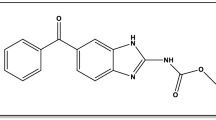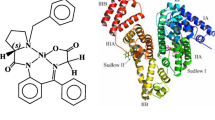Abstract
Fluorescence spectroscopy in combination with UV–vis absorption spectroscopy was employed to investigate the binding of an important traditional medicinal herb berberine to bovine serum albumin (BSA) under the physiological conditions. In the mechanism discussion, it was proved that the fluorescence quenching of BSA by berberine is a result of the formation of berberine–BSA complex. Fluorescence quenching constants were determined using the Stern–Volmer equation and Scatchard equation to provide a measure of the binding affinity between berberine and BSA. The results of thermodynamic parameters ΔG, ΔH, ΔS at different temperatures indicate that the electrostatic interactions play a major role for berberine–BSA association. Site marker competitive experiments indicated that the binding of berberine to BSA primarily took place in site II. Furthermore, the Effect of supramolecules to berberine–BSA system, and the distance r between donor (BSA) and acceptor (berberine) was obtained according to fluorescence resonance energy transfer (FRET).





Similar content being viewed by others
References
Cho JY, Baik KU, Yoo ES, Yoshikawa K, Park MH (2000) In vitro antiinflammatory effects of neolignan woorenosides from the rhizomes of Coptis japonica. J Nat Prod 63:1205–1209
Domadia PN, Bhunia A, Sivaraman J, Swarup S, Dasgupta D (2008) Berberine targets assembly of escherichia coli cell division protein FtsZ. Biochemistry 47:3225–3234
Bjorklund JA, Frenzel T, Rueffer M, Kobayashi M, Mocek U, Fox C, Beale JM, Grtiger S, Zenk MH, Floss HG (1995) Cryptic stereochemistry of berberine alkaloid biosynthesis. J Am Chem Soc 117:1533–1545
Küpeli E, Koşar M, Yeşilada E, Başer KHC, Başer C (2002) A comparative study on the anti-inflammatory, antinociceptive and antipyretic effects of isoquinoline alkaloids from the roots of Turkish Berberis species. Life Sci 72:645–657
Weber HA, Zart MK, Hodges AE, Molloy HM, O’brien BM, Moody LA, Clark AP, Harris RK, Overstreet JD, Smith CS (2003) Chemical comparison of goldenseal (Hydrastis canadensis L.) root powder from three commercial suppliers. J Agric Food Chem 51:7352–7358
Hsieh S, Kuo WH, Lin TW, Chang HR, Lin TH, Chen PN, Chu SC (2007) Protective effects of berberine against low-density lipoprotein (LDL) oxidation and oxidized LDL-induced cytotoxicity on endothelial cells. J Agric Food Chem 55:10437–10445
Shamsa F, Ahmadiani A, Khosrokhavar R (1999) Antihistaminic and anticholinergic activity of barberry fruit (Berberis vulgaris) in the guinea-pig ileum. J Ethnopharmacol 64:161–166
Kim JP, Jung MY, Kim JP, Kim SY (2000) Antiphotooxidative activity of protoberberines derived from Coptis japonica makino in the chlorophyll-sensitized photooxidation of oil. J Agric Food Chem 48:1058–1063
Liu Y, Yu H, Zhang C, Cheng Y, Hu L, Meng X, Zhao Y (2008) Protective effects of berberine on radiation-induced lung injury via intercellular adhesion molecular-1 and transforming growth factor-beta-1 in patients with lung cancer. Eur J Cancer 44:2425–2432
Bhadra K, Maiti M, Kumar GS (2008) Berberine–DNA complexation: New insights into the cooperative binding and energetic aspects. Biochim Biophys Acta 1780:1054–1061
Peters T (1996) All about albumin: biochemistry, genetics and medicinal applications. Academic Press, San Diego, CA
Kumar CV, Buranaprapuk A, Opiteck GJ, Moyer MB, Jockusch S, Turro NJ (1998) Photochemical protease: site-specific photocleavage of hen egg lysozyme and bovine serum albumin. Proc Natl Acad Sci USA 95:10361–10366
Carter DC, Ho JX (1994) Structure of serum albumin. Adv Protein Chem 45:153–203
Carter DC, Chang B, Ho JX, Keeling K, Krishnasami Z (1994) Preliminary crystallographic studies of four crystal forms of serum albumin. Eur J Biochem 226:1049–1052
Olson RE, Christ DD (1996) Plasma protein binding of drugs. Ann Rep Med Chem 31:327–336
Zhang HX, Gao S, Yang XX (2009) Synthesis of an octupolar compound and its biological effects on serum albumin. Mol Biol Rep 36:1405–1411
Tong JQ, Zhang HX, Yang HM, Mei P (2009) Photochemical studies on the binding of an organic fluoride to bovine serum albumin. Mol Biol Rep. doi:10.1007/s11033-009-9598-z
Zhang HX, Gao S, Xiong ZY, Liu SP (2009) Fluorometric probing on the binding of hematoxylin to serum albumin. Mol Biol Rep 36:2299–2306
Zhang HX, Huang X, Zhang M (2008) Spectral diagnostics of the interaction between pyridoxine hydrochloride and bovine serum albumin in vitro. Mol Biol Rep 35:699–705
Abuin E, Calderón C, Lissi E (2008) Interaction of alkylpyridinium chlorides with human serum albumin studied by fluorescence techniques. J Photochem Photobiol A 195:295–300
Lakowicz JR (2006) Principles of fluorescence spectroscopy, 3rd edn. Springer, New York
Lehrer SS (1971) Solute Perturbation of Protein Fluorescence. The quenching of the tryptophyl fluorescence of model compounds and of lysozyme by iodide ion. Biochemistry 10:3254–3263
Timaseff SN (1972) Thermodynamics of protein interactions. In: Peeters H (ed) Proteins of biological fluids. Pergamon Press, Oxford
Ross PD, Subramanian S (1981) Thermodynamics of protein association reactions: Forces contributing to stability. Biochemistry 20:3096–3102
Scatchard G (1949) The attractions of proteins for small molecules and ions. Ann N Y Acad Sci 51:660–672
He XM, Carter DC (1992) Atomic structure and chemistry of human serum albumin. Nature 358:209–215
Jisha VS, Arun KT, Hariharan M, Ramaiah D (2006) Site-selective binding and dual mode recognition of serum albumin by a squaraine dye. J Am Chem Soc 128:6024–6025
Sudlow G, Birkett DJ, Wade DN (1975) Characterization of two specific drug binding sites on human serum albumin. Mol Pharmacol 11:824–832
Sudlow G, Birkett DJ, Wade DN (1976) Further characterization of specific drug binding sites on human serum albumin. Mol Pharmacol 12:1052–1061
Hu YJ, Liu Y, Xiao XH (2009) Investigation of the interaction between berberine and human serum albumin. Biomacromolecules 10:517–521
Zhu XS, Hu YY, Gong AQ (2007) Investigation on the interaction of tetrachloride fluorescein–bovine serum albumin-β-cyclodextrin and the determination of protein by flow injection analysis. Anal Chim Acta 592:24–29
Förster T (1948) Intermolecular energy transference and fluorescence. Ann Phys 2:55–75
Valeur B, Brochon JC (1999) New trends in fluorescence spectroscopy. Springer, Berlin
Zhang YZ, Dai J, Xiang X, Li WW, Liu Y (2010) Studies on the interaction between benzidine and bovine serum albumin by spectroscopic methods. Mol Biol Rep 37:1541–1549
Yang JY, Yang WY (2009) Site-specific two-color protein labeling for FRET studies using split inteins. J Am Chem Soc 131:11644–11645
Valeur B (2001) Molecular fluorescence: principles and applications. Wiley, New York
Acknowledgements
The authors gratefully acknowledge financial support of National Natural Science Foundation of China (Grant Nos. 20803019, 20873096, and 20921062), the Research Foundation of Education Bureau of Hubei Province, China (Grant No. Q20082205), and Hubei Normal University Foundation, China (Grant No. 2007F10).
Author information
Authors and Affiliations
Corresponding author
Electronic supplementary material
Below is the link to the electronic supplementary material.
Rights and permissions
About this article
Cite this article
Hu, YJ., Ou-Yang, Y., Dai, CM. et al. Binding of berberine to bovine serum albumin: spectroscopic approach. Mol Biol Rep 37, 3827–3832 (2010). https://doi.org/10.1007/s11033-010-0038-x
Received:
Accepted:
Published:
Issue Date:
DOI: https://doi.org/10.1007/s11033-010-0038-x




